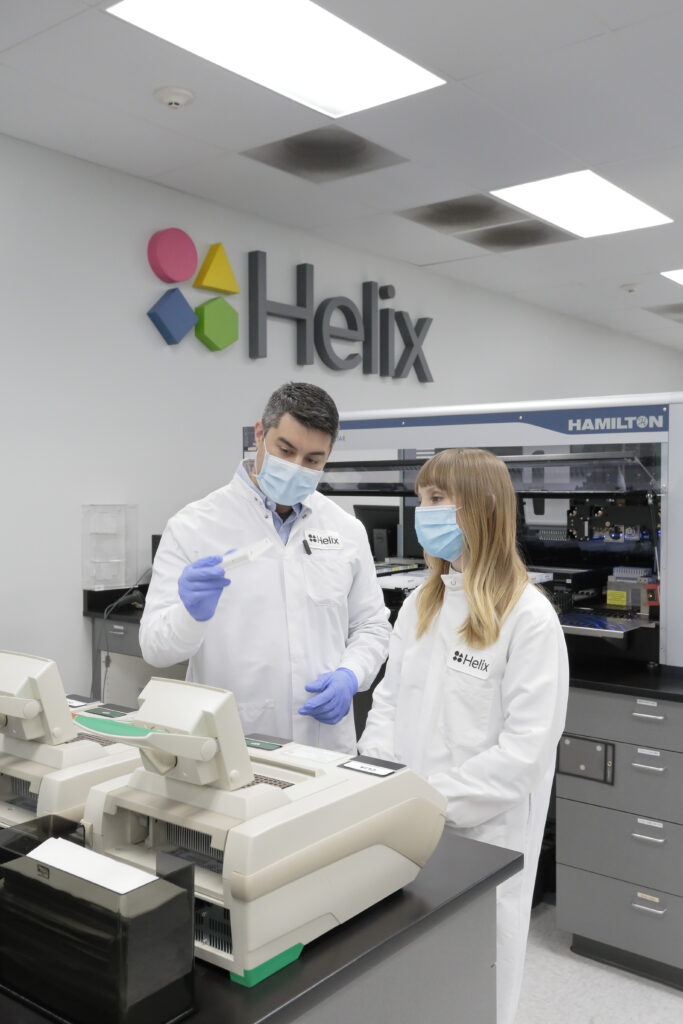![A demonstration of DNA sequencing output from an ABI 373 automated sequencer. [National Human Genome Research Institute (NHGRI)]](https://horviral.com/wp-content/uploads/2024/06/Helix-Recursion-alliance-aims-for-AI-driven-genomic-drug-discovery.jpg)
A demonstration of DNA sequencing output from an ABI 373 automated sequencer. [National Human Genome Research Institute (NHGRI)]
The UK Biobank, with genetic data on half a million individuals, set a benchmark for scale in medical research. It contains whole-genome sequence data for all 500,000 participants, making it the world’s largest genetics project to date.
A recent collaboration between San Diego-based clinical genomics company Helix and Salt Lake City-based biotech Recursion Pharmaceuticals aims to go even further. “We could pass [UK Biobank] maybe by the end of 2025,” says Helix’s Hylton Kalvaria.
The partnership will combine Helix’s growing clinical genomic data set with more than 25 petabytes of Recursion’s proprietary biological and chemical data.
The world is full of data. To cite one example, the latest CommonCrawl dataset, which includes 17 years of website data, totals 377 tebibytes. This is equivalent to the storage capacity of more than 3 million 128 gigabyte USB flash drives.
“There are bigger sources of data out there,” Kalvaria acknowledged. “But [the combined Helix-Recursion dataset] it’s still a heck of a lot of data and, more importantly, it adds up over time.”
The “sequence once, ask often” model: Unlocking genetic knowledge throughout life

Helix researchers in the lab [Helix]
Helix is not only focused on building a massive genomic database. The company follows a “sequence once, query often” approach to genomic data management. “Your genetics is the one thing about your health that never changes over time,” Kalvaria said. Having this information available in advance can offer a number of advantages in either routine care or disease diagnosis. “There are many reasons why you might return to her [genomic] information over time”, Kalvaria added.
For patients, a single DNA sequence can provide knowledge for years to come, eliminating the need for further repeated genetic tests. For physicians, access to patient genomic information can support faster, more informed decisions. Kalvaria notes, “If a patient has already been sequenced, results can be obtained in minutes rather than weeks.” In the long term, physicians could potentially confirm or rule out genetic conditions during an office visit using such data in the context of patient care. As scientists learn more about how genes are linked to disease, such available genetic data can help identify patients who may benefit from specific treatments or preventative measures.
The benefits also extend to healthcare systems: For example, reducing duplicate testing can lead to cost savings and more efficient use of resources. The potential impact of this method goes beyond saving time and money.
BioHive-2: The supercomputer that informs the drug hunt
While the potential of genomic data mining to improve patient care and more targeted drug discovery is not new, deciphering such data is not necessarily straightforward. To help uncover hidden connections between genes, diseases and potential treatments, Helix is turning to Recursion Pharmaceuticals and its secret weapon: BioHive-2.
This is not your used supercomputer. Powered by 504 of NVIDIA’s latest H100 Tensor Core GPUs, BioHive-2 is purpose-built for AI-driven drug discovery. Recursion estimates that the computer, four times faster than its predecessor, is currently the fastest, wholly owned supercomputer in the pharmaceutical industry globally.

Hylton Calvary
Over the past decade, Recursion has also amassed one of the world’s largest collections of biological and chemical data. Now that its supercomputer, BioHive-2, is up and running, it plans to use the horsepower to create more advanced AI models that could help improve the drug discovery process.
“We are really excited to work with him [Recursion] and make those new discoveries that will bring medicines to patients faster”, said Kalvaria.
The potential advantages of the drug development life cycle extend from the laboratory to the market
While it is difficult to quantify how the partnership will affect the drug development workflow, the efficiency gains could be significant. “Ultimately, that’s how we see our role in this drug development lifecycle,” Kalvaria noted. “Help people control more things, interrogate more drug targets than ever before.”
Technology partnerships can also inform the commercialization of drugs once they reach the market. “We have this footprint with health systems where we can actually serve patients who might be good candidates for a new drug coming to market,” Kalvaria said.
Filed under: Drug Delivery, Genomics/Proteomics, Machine Learning & AI, Omics/Sequencing
#HelixRecursion #alliance #aims #AIdriven #genomic #drug #discovery
Image Source : www.drugdiscoverytrends.com
